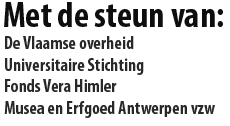D. CALLEWAERT
Het boze oog
Summary: The Evil Eye
From times immemorial many people from all over the world have been convinced that a special, (un)intentional,
frontal eye contact of a person or animal can harm people, live stock, goods and chattels. This belief has remained intact because of news items, stories for young and old, computer games and comics, pieces of art, amulets, Adidas ‘Evil Eye’ sunglasses, etc.
It is a sender-receiver relationship and there are means to avoid or undo enchantment: keep distance and don’t look; provoke or intimidate (spit, make obscene gestures, wear erotic artefacts, show a ‘reflecting’ human/animal eye,…), use amulets (hand of Fatimid, red coral, brass, …). One should know the appropriate shape, colour, element, place and action to neutralize the Evil Eye.
,
G.WILLEMS, L. VAN DE VIJVER, PH. MEERS, D. BILTEREYST
Bioscopen, moderniteit en filmbeleving. Deel 2: bioscoopbeleving en filmcultuur in landelijke en minder verstedelijkte gebieden in Vlaanderen (1925-1965)
Summary: Movies: modern times and film perceptions. Part 2: movie perceptions and film culture in the rural and less urbanized parts of Flanders (1925-1965)
This contribution is the final piece of a twofold about movie theatres, modern times and film perceptions in Flanders and puts the audiences in Flemish cities and villages in the spotlight. Through oral history as a methodological point of view, we will take a look at how the Flemish audience actively coped with the movie landscape and how they gave it their own interpretation and meaning. The different ‘perceived’ film culture in cities and villages and the roll and meaning of movie theatres in the daily lives of the movie goer in city and village are the focal point of this contribution. We will mostly pay attention for the differences in the programming, options and the actual perception of cinema in urban centre venues, local movie theatres and village movie theatres. The results we obtain stress that movies have been a very important aspect our free time during most of the twentieth century. This was also the case in the numerous Flemish villages and smaller towns that had one or more movie theatres. Even there, cinema fulfilled very different functions. A key aspect is that cinema not only provided personal needs (movie as a source of fantasy, escapism, fin, feeling of freedom or lack of control), but it also contributed significantly to a certain social cohesion. This contribution also pays attention to the direct and indirect ways in which the catholic movement tried to influence cinema as a free time pattern. Here also, not only the way how the catholic movement worked but the actual perception of the audience in cities and villages proved to be different.
,
M.M.A.C. LANGENHUIJSEN
Het votiefgebruik in twee middeleeuwse mirakelboeken
Summary: The use of votives in two miracle books
The miracle books of Our Lady of ’s Hertogenbosch and Anno II in Siegburg respectively contain 481 accounts from 1382 until 1603 and 295 from 1183 until 1185.
Besides votive gifts in a more restricted sense of the word, sacrificed after hearing a plea for help, also offered in advance, both describe so-called sacred gifts. On the miracle book of Anno, these last comprise more than a quarter of all gifts. This may contribute to explaining the discrepancy between the numerous gifts and the expected low number of healings. Also over-estimation of the seriousness of the disorder can lead to this.
Impairments in the liveliness of legs and feet were the most common, followed by problems concerning sight and arm and hand complaints. Psychiatric disorders were accompanied by gifts like ‘offerings’, body weight in kind, images of the human body or the heart and only once of a wax head. Was brains served as a symbol for headache, swollen heads, fever or serious illness. Votive heads were related exclusively to disorders of the head. Images of the human body and weighing gifts were multifunctional. The last ones were especially given with children.
,

